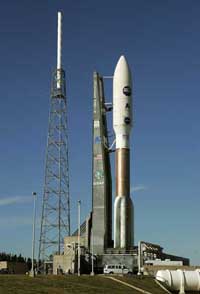| Home / International / International -- World | Tools: Save | Print | E-mail | Most Read |
| 1st Pluto Probe Begins 9-year Trip |
| Adjust font size: |
New Horizons, the first spacecraft to visit Pluto, blasted off from the Cape Canaveral Air Force Station, Florida, at 2:00 PM EST (19:00 GMT), after two delays in the past two days. High winds at the launch pad forced a delay on Tuesday afternoon, and a power failure at the Maryland laboratory managing the mission prevented the second try planned on Wednesday afternoon. On Wednesday morning, a major power outage blamed on a storm hit the area of the Johns Hopkins University Applied Physics Laboratory that operates the probe and manages the mission. Thursday's successful liftoff was within a launch time frame ending Jan. 27 that will allow New Horizons to get a boost in its velocity from Jupiter's gravity field so as to arrive at Pluto as early as mid-2015. Scientists believe a direct flight to Pluto would take as much as four more years. Pluto is the last unexplored planet in the solar system. Scientists hope the US$7 million exploration mission could increase their understanding of the formation of the planets. The piano-sized probe was carried into space by an Atlas V rocket. It is expected to travel across the entire span of the solar system at unparalleled speeds of up to 75,000 km per hour. The probe, of 454 kg in weight and equipped with seven scientific instruments, will conduct flyby studies to the icy Pluto and its large moon Charon. The fast flying New Horizons does not carry enough fuel to make slowdowns that allow it to enter the orbit of Pluto. Since Pluto is too far away from the sun, the probe cannot use solar energy and will rely on the power from the radioactive decay of 24 pounds of plutonium pellets it carries. At the end of its one-way trip, New Horizons will fly beyond Pluto and Charon to enter the surrounding Kuiper Belt for a five-year study of the icy and rocky bodies there. The Kuiper Belt is believed to consist of remainders from the early formation of the solar system.
(Xinhua News Agency January 20, 2006) |
| Tools: Save | Print | E-mail | Most Read |
 |
| Related Stories |
|
| ? |

